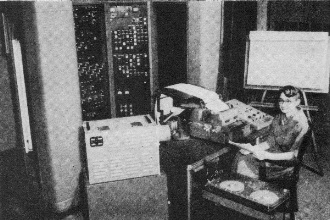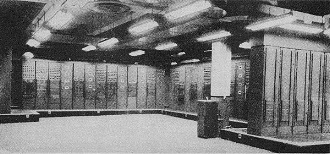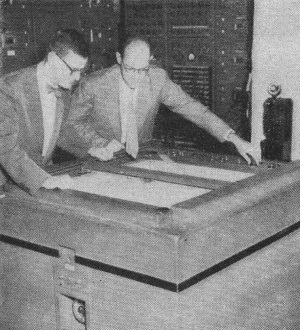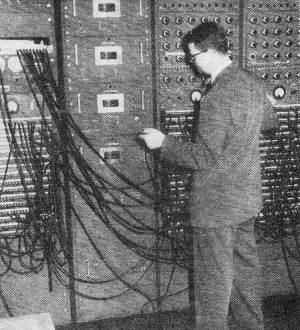Project Cyclone
|
|
Increasing women's roles and interest in STEM (science, technology, engineering, mathematics) careers has been a major effort by schools in the last couple decades in an attempt to "remove barriers," both real and perceived, inhibiting entrance into the fields. There are still many realms of STEM that women have avoided, but computer programming and mathematics are examples their representation having seen steady increases. Dr. Frances Bauer can be seen in this 1955 Popular Electronics magazine story on Project Cyclone, which reports on her role programming what was at the time one of the largest computers in the world. Her work ran the gamut between civil engineering on bridge projects to predicting missile flight paths for the military. You might recall the U.S. Navy's Grace Hopper, who is credited with coining the term "bug" for computers. Project Cyclone The lady builds bridges and test-flights rockets. Dr. Frances Bauer feeds data to computer, gets speedy and accurate results. One of the largest computers in the world. "Project Cyclone" is the test center for solving three-dimensional problems involved in the design of aircraft and guided missiles. Giant computers solve industry's toughest problems and open new, lucrative field for women interested in mathematics. The new "Age of Automation" being ushered in by electronic computers will open up many new technical and highly remunerative fields to women. As mathematicians who "program" or "feed" data into the electronic "brains," women will be able to build bridges and tunnels, design dams for hydroelectric plants, pre-test the flight of planes, tell automobile manufacturers what is wrong with next year's models, and maybe even forecast the weather weeks ahead of time. A number of women have already pioneered in this new field and are finding that their sex is no barrier to their advancement. While the machines can make their calculations in minutes, often in seconds, the human "programming" or breaking down of the problems to be solved into a series of mathematical formulae so that machines can "digest" them, may take hours or even days. One of these machines, for instance, requires 963 instructions to calculate the path of a guided missile. Once these instructions are received by the computer, it can perform 1,100,000 mathematical operations in exactly two minutes. A human would probably require a year to complete the job. One of the women pioneering in this new field is Dr. Frances Bauer, senior mathematician at Reeves Instrument Corporation, New York City, a subsidiary of Claude Neon, Inc. She assists her husband. Dr. Louis Bauer, in the operation of the famed "Project Cyclone," built and operated by Reeves for the U.S. Navy's Bureau of Aeronautics. She also serves as a consultant on industrial problems involving the use of the Reeves Analogue Computers (REAC). A Ph.D. from Brown University and a former Research Associate in Aeronautical Structures at the Polytechnic Institute of Brooklyn, petite, blond Frances Bauer - still in her early thirties - has been called upon in the four years since she came to Reeves to pre-check the performance of such deadly guided missiles and military aircraft as the Lark, Regulus, Cutlass, and Nike. Real rocket tests cost hundreds of thousands of dollars but the "test flights" performed for the Navy by Dr. Bauer and her colleagues at "Project Cyclone" cost little and endanger no lives. In one instance the Navy was advised, as a result of the work at "Project Cyclone," not to try to launch certain jet fighters from the deck of a pitching carrier. The computer proved that they were much too likely to go into the drink instead of taking off safely.
Project director Dr. Louis Bauer (left) and Hans Meissinger, assistant, study missile's trajectory while it is computed and drawn.
Electronics makes for safety and accuracy as Dr. Bauer watches the pull out of a dive bomber to determine point of bomb release. Recently at Reeves, Dr. Bauer and her associates were called upon to help solve certain problems in the building of suspension bridges. On another occasion officials of the Tennessee Valley Authority presented certain questions on the operation of TVA's thirty-five dams. Dr. Bauer, who says there are already several hundred women in this field, advises young women interested in mathematics who are entering college this fall and others already employed but who are looking for wider horizons, to investigate this profession of playing handmaiden to an electronic "brain." Graduate work in mathematics is advisable but not necessary. Girls with a B.A. may expect to start at $65 to $75 per week. Those with an M.A. may get $85 to $100, while the PhDs will command around $125 weekly in the industrial market. Fully qualified professionals in the field may expect anywhere from $8,000 to $12,000 per year and reportedly there are already a few women computer experts in the $25,000 per year bracket. Who said figures weren't interesting?
Posted December 13, 2022 |
|




